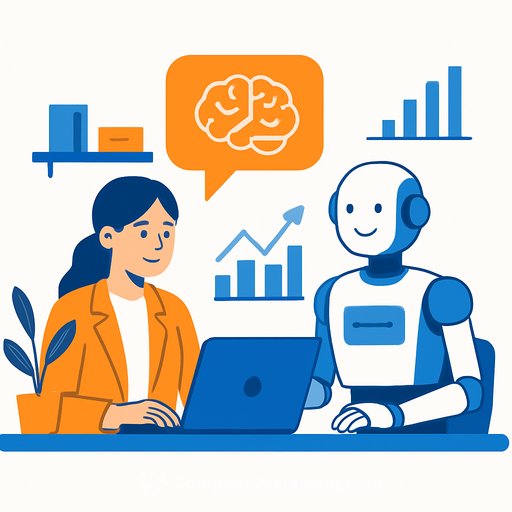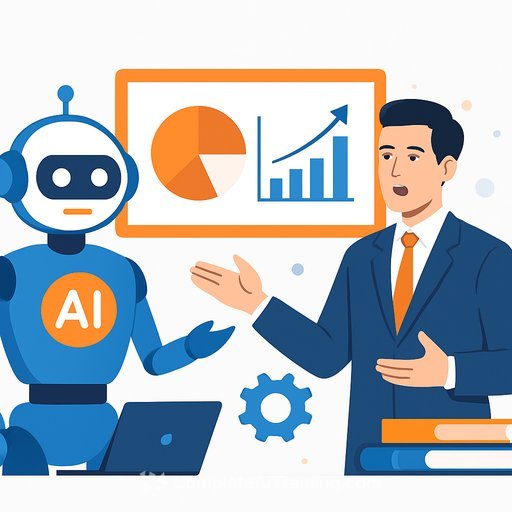How AI Is Changing Small-Business Work: A Practical Brief for Managers and HR
Artificial intelligence is becoming the assistant small teams didn't know they needed. Laurie McCabe of SMB Group puts it plainly: small businesses still care most about winning customers, improving productivity and controlling costs - and AI is helping them do it.
The external pressures haven't let up: inflation, recession concerns, supply chain hiccups and cybersecurity. What has shifted is mindset. SMBs now see technology as a growth engine, with AI speeding up gains they were already chasing with automation.
What's actually changing on the ground
According to SMB Group's latest research, AI adoption is accelerating across small and midsize businesses. Only 18% report no plans to use AI. 53% say they're already using it. Source: SMB Group, August 2025.
The smallest firms - especially under 10 employees - are more likely to be on the sidelines due to time, skills and budget constraints. For those using AI, the biggest wins today are productivity, collaboration and customer satisfaction. Planning and forecasting gains are coming next.
Jobs are changing - here's how to handle it
Among SMBs already using AI, 16% report they've replaced jobs with AI, with that figure expected to reach 25% within a year. That doesn't always mean layoffs. Roles are being re-scoped, and backfills aren't always needed when people leave.
The smart move: take your trusted, high-performing people and reskill them into higher-value work. Shift time from manual processing (invoices, expense reports, basic customer responses) to analysis, relationship building and continuous improvement.
Start here: a manager and HR playbook
- Pick one problem and one KPI. Example: reduce average response time by 30% or cut invoice processing time in half.
- Map the workflow. Identify repeatable, high-volume steps. Automate the boring, keep humans for judgment and exceptions.
- Use tools you already own. Turn on AI features in your email, documents, spreadsheet, CRM, help desk or HR systems before buying new software.
- Set guardrails. Create a simple AI-use policy: what data is allowed, what must be reviewed by a human, and how outputs are documented.
- Run a 30-day pilot. Small group, clear playbook, weekly check-ins, hard metrics.
- Measure and decide. If the KPI moved, expand. If not, adjust prompts, training, or the workflow and try again.
High-ROI use cases by function
- Sales/Marketing: draft emails and proposals, summarize calls, segment leads, repurpose content.
- Customer Service: suggested replies, routing and tagging, knowledge-base updates, post-call summaries.
- Finance: invoice capture and coding, expense reviews, receipt matching, cash-flow notes; later, forecasting.
- HR/People Ops: job descriptions, structured screening questions, onboarding checklists, pulse-survey summaries.
- Operations/Supply: reorder reminders, exception flags, shipment status summaries, basic demand notes.
- Admin/Back Office: meeting notes, task lists, document drafts, policy cleanups.
Risk and governance: simple rules that work
- Security and privacy first. Don't paste confidential or regulated data into public tools. Check vendor data retention and training policies.
- Human-in-the-loop. Require review for external communications, financial entries, and HR decisions.
- Bias checks. Spot-check hiring and customer-facing outputs for fairness and accuracy.
- Copyright/IP. Keep humans accountable for originality and citations in public content.
- Cost controls. Limit licenses to active users, set usage alerts, and track ROI monthly.
- Document decisions. Save prompts, versions and approvals for traceability.
For a trusted framework, see the NIST AI Risk Management Framework.
Closing the skills gap fast
- Pick champions. One per team to test tools, write playbooks and run quick trainings.
- Teach three skills: prompting basics, workflow thinking, and data hygiene.
- Make practice weekly. 60 minutes to document one workflow win per person.
- Codify what works. Save prompts and checklists in a shared library and keep them current.
If you need structured upskilling by role, explore AI courses by job and practical certifications that focus on workflow outcomes.
Why small teams have an edge
Smaller companies can pick a single target, roll out a pilot and adjust quickly. That focus is an advantage over bigger firms with layers of approvals.
The data is clear: most SMBs are moving on AI, and they're seeing gains in productivity, collaboration and customer satisfaction. Choose one meaningful use case, set a metric, and prove value in 30 days - then scale what works.
Your membership also unlocks:










